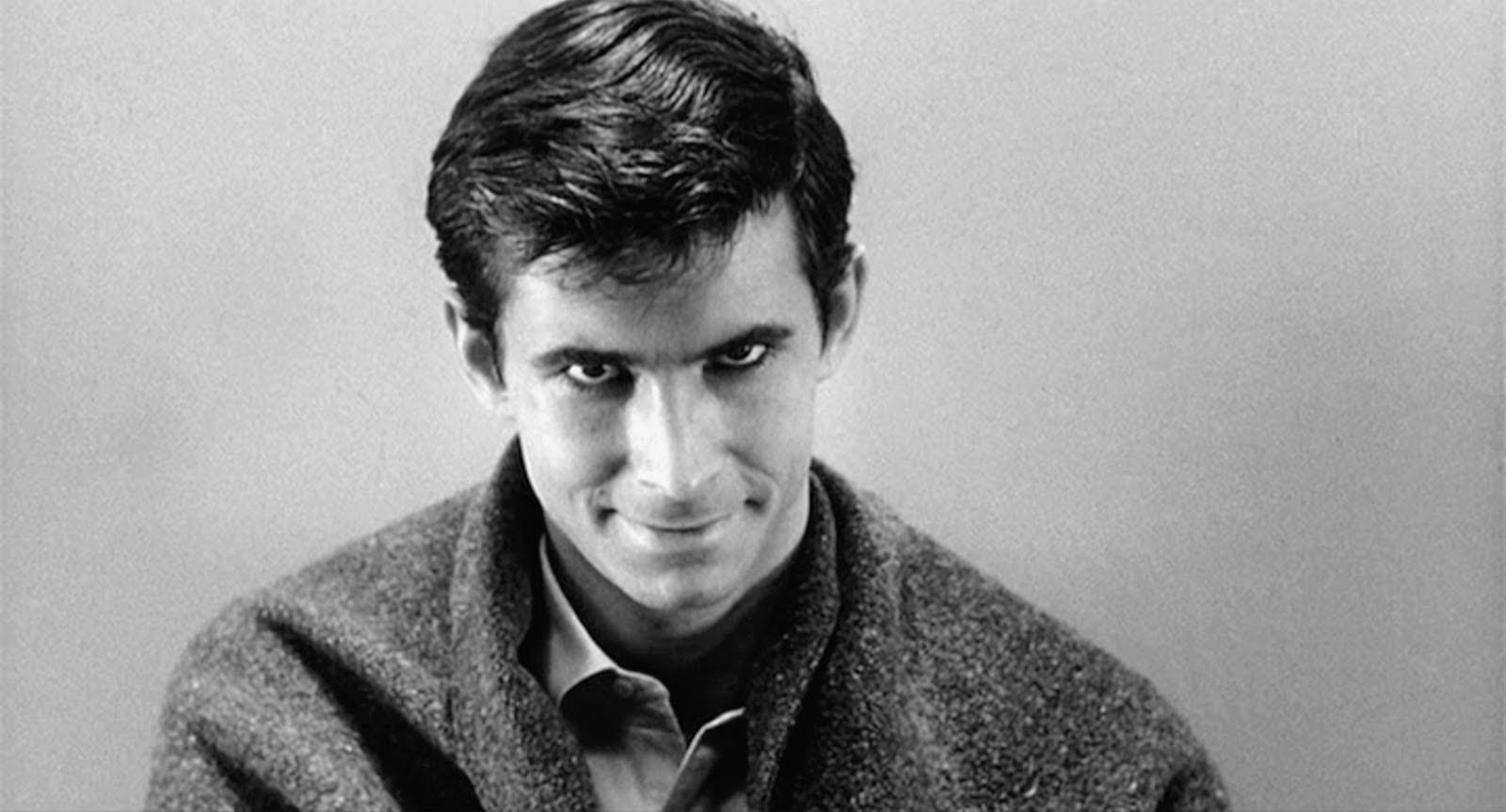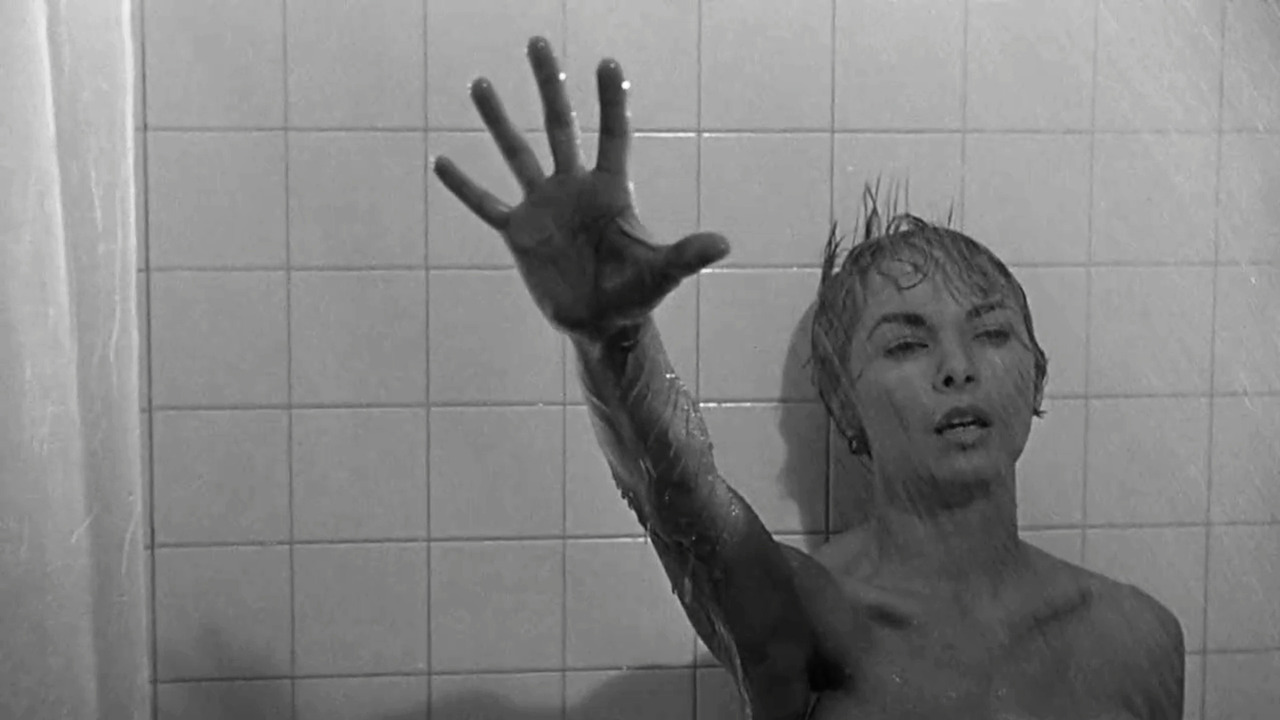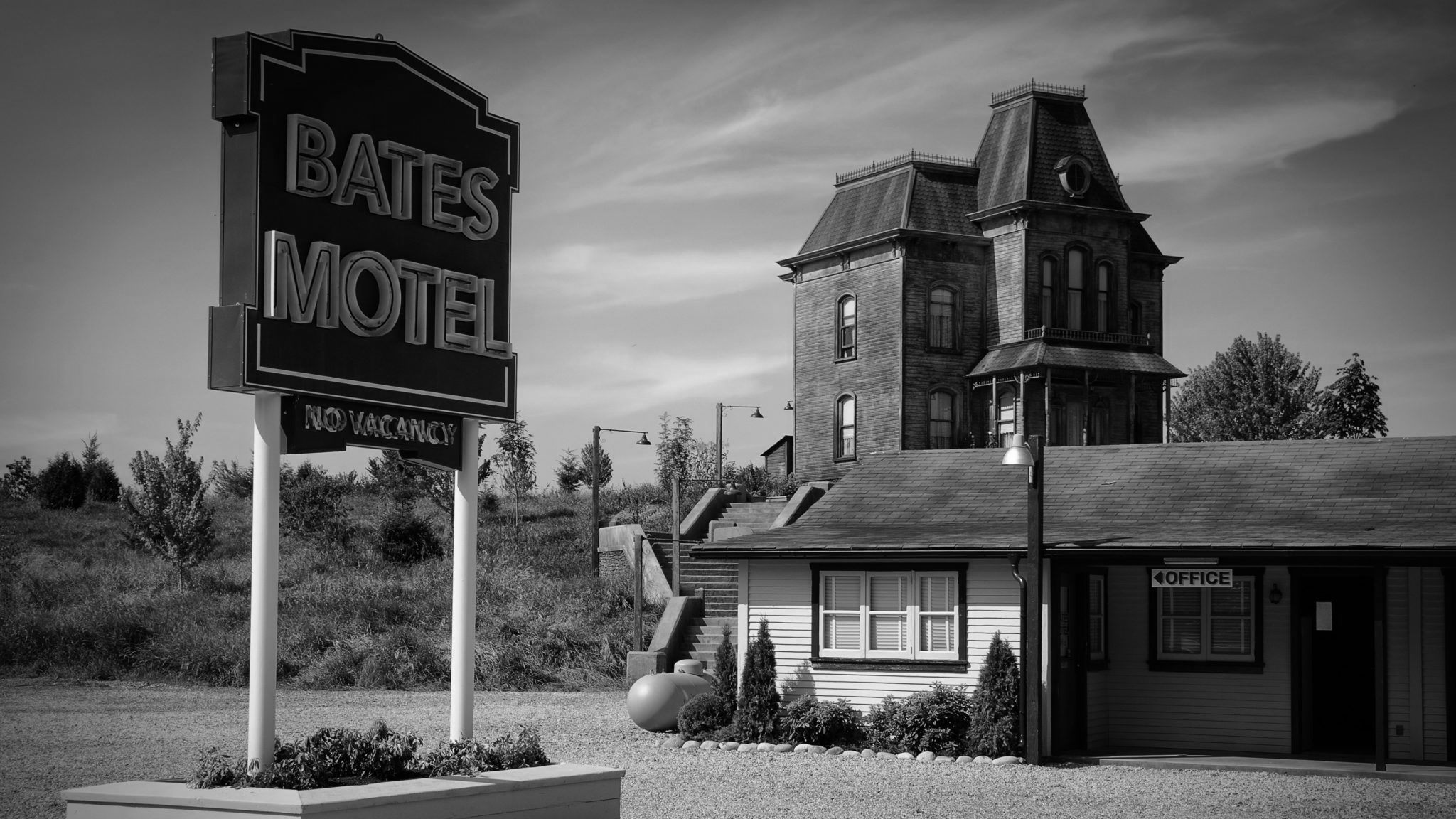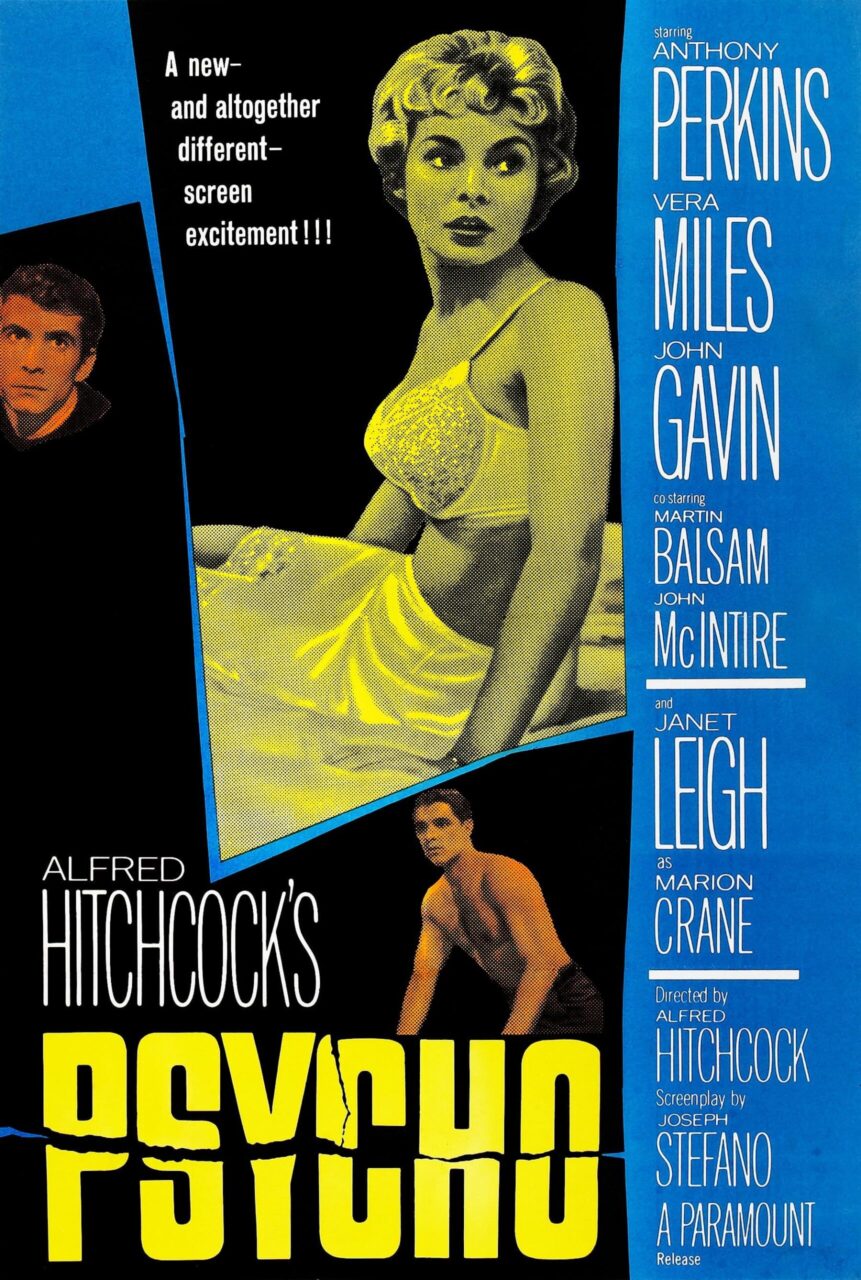USA. 1960.
Crew
Director/Producer – Alfred Hitchcock, Screenplay – Joseph Stefano, Based on the Novel Psycho (1959) by Robert Bloch, Photography (b&w) – John L. Russell, Music – Bernard Herrmann, Special Effects – Clarence Champagne, Makeup – Jack Barron & Robert Dawn, Art Direction – Robert Clatworthy & Joseph Hurley. Production Company – Shamley.
Cast
Anthony Perkins (Norman Bates), Janet Leigh (Marion Crane), Vera Miles (Lila Crane), John Gavin (Sam Loomis), Martin Balsam (Milton Arbogast)
Plot
Secretary Marion Crane is given $40,000 to bank by her boss. Instead she takes the money with the intent of using it to help her lover Sam Loomis out of debt. She flees, driving from Phoenix City to California. That evening she stops off to spend the night at a lonely backroad motel run by Norman Bates. However, when she goes to take a shower, she is stabbed to death by what appears to be Norman Bates’s mother. When Loomis and Marion’s sister Lila come investigating, they encounter the twisted mind of Norman Bates, dominated by the memory of his dead mother to the extent that he is driven to dress up as her and kill the women he is attracted to.
One hates to draw up All-Time Bests lists but without any doubt Psycho is one of the greatest and certainly the most famous of all horror films. It features in both the American and British Film Institutes’ Top 100 lists. At the time Psycho was made, Alfred Hitchcock has risen from a young director of promise in early English sound cinema to making a series of great thrillers during the 1930s and 40s. In the 1950s, Hitchcock had successfully made the move into colour, producing some of his finest work during this time. By the time of Psycho, Hitchcock was out of favour with Universal who granted the film a less-than-stellar budget.
Despite their disinterest in the film, Psycho proved an unexpected sleeper, largely due to a judicious release campaign where Hitchcock managed to get theatres to sign a contract that refused to let people in after the film had started. Few understood Psycho at the time and it took some time for it to attain its classic status. Alfred Hitchcock was nominated for a Best Director by the normally conservative Academy Awards but Time Magazine for example failed to include Psycho in that year’s Top 10 list but the following year included William Castle’s inferior Psycho copy Homicidal (1961) on the list. Psycho has since become acknowledged as a cinematic landmark.
Psycho adapts a 1959 novel by Robert Bloch (who on the basis of this sole credit became a major name in horror writing particularly during the 1960s). The book is an effective psycho-thriller but one suspects if filmed as it was it would never have become the classic it is today. The most distinctive difference between the film and the book is that of Robert Bloch’s characterisation of Norman Bates as corpulent and bespectacled, something the film almost entirely reverses. What made the crucial difference was the film’s expanding the first few chapters of the book out into an extended preamble where we become engaged in the mundane amateur theft and flight of Marion Crane.

There are many reasons why Psycho is a classic. One of the principal reasons is its structure. The first hour of the film is construed as one giant seduction of the audience upon Alfred Hitchcock’s part. We are drawn into Janet Leigh’s cross-country flight. Hitchcock keeps us perpetually on edge and intensively involved. The scenes have an edgy paranoia – the alienating openness of the desert highways; the sinister cop in the mirror shades peering through the car window; Marion’s apprehensiveness as she sees her boss crossing the street or the cop car returning as she tries to conduct the car sale. After involving us in this small crime and flight for nearly an hour, Alfred Hitchcock then kills the protagonist off with a jolting abruptness. It is a genuine shock pulling the carpet out from under our feet – involving us in one story and then conducting a startling switching of the tracks in the middle of it. (Hitchcock did similar things in The Birds (1963) a couple of years later).
Of course, the shower scene where Janet Leigh is killed has gone on to become probably the single most famous scene in cinema history. It is important to analyse exactly what is so classic about it. There had been murder and death depicted on screen before but never had it been so exactingly staged and methodically detailed. For an era when most death was only shown in terms of absurd bulletholes the size of a dime that never managed to spill any blood, this must have come as a considerable shock.
Secondly, there is the very coldness of the scene. There is such precise randomness to the detail that Alfred Hitchcock shows us – the way Janet Leigh falls across the bathroom floor, the shower curtain popping off its rings as she falls, the camera observing with cool detachment the flow of blood down the drain and her blankly open eye as her bodies lies on the floor. Never before had death been rendered with such coldness and such unromanticised lack of dignity. The very next scene – Norman’s cleanup of the room – is one that Hitchcock follows with mathematically exacting precision – the scene is a continuity person’s dream. Perhaps the greatest chill this scene holds is seeing the $40,000 tossed away and sunken into the swamp without even a second thought. Clearly, there was something even more disturbing than simply petty crime going on here.

And certainly there was. Psycho was the first of a new type of film – the Psycho-Thrillers. There had been mad killers in various works of film noir and earlier than that in films such as The Cat and the Canary (1927) and Hitchcock’s own The Lodger: A Story of the London Fog (1927). However, these are largely works of Grand Guignol melodrama where psychopathology involved lots of sweaty, twitchy barnstorming and unnerving glares of an actor and was all theatric effect but held little in the way of psychological motivation. Psycho invoked Freudian psychology as motivation and cut the psycho-thriller through with a host of Freudian childhood traumas, split personalities and confused gender roles.
The crucial piece of damage that Psycho did to liberal psychology was to forever tie psychopathology to a Puritanical view of sexuality. It is a view that lurks at the basis of every psycho-horror film since from the Italian giallo film to slasher films such as Halloween (1978) and Friday the 13th (1980) and modern descendants of Psycho like Fatal Attraction (1987) and Basic Instinct (1992). The central underlying thesis of Psycho is that sex screws you up. We are first introduced to Marion Crane in a hotel room where it is implied that she has just been having a sexual tryst with her unmarried lover. It is hard to believe today but at the time the sight of Janet Leigh in a black bra was something shockingly licentious and has been more than once mentioned as having an erotic charge for viewers of the time. Later we are invited to voyeuristically join in and watch from Norman’s point-of-view as she undresses and showers. When Marionis killed, it seems that she is being punished for being so provocative, that she stirred Norman’s sexual urges, which his puritanical mother then needed to come into action and clamp down on by killing Marion. There is the sense behind Psycho that in letting such permissiveness out of the bag, we unwittingly stir up something that has become so repressed and fucked up that when it is emerges it does so with lethal consequences. This similar sense – that freedom of sexuality cannot be permitted without deadly consequences resulting – runs through all the abovementioned films and innumerable copies of them.
Psycho was enormously influential. The shower sequence has been quoted and parodied in numerous films including The Phantom of the Paradise (1974), High Anxiety (1977), Squirm (1976), Dressed to Kill (1980), Fade to Black (1980), The Funhouse (1981), Monster in the Closet (1986), Killer Tomatoes Strike Back! (1991), The Killer Condom (1996), Scream 2 (1997), From Dusk Till Dawn 2: Texas Blood Money (1999), Looney Tunes: Back in Action (2003) and Charlie and the Chocolate Factory (2005). In Halloween (1978) and sequels, John Carpenter names Donald Pleasence’s psychiatrist Sam Loomis in homage to the character here. MaXXXine (2024) features a sequence set around the Bates motel set.

There were three sequels – Psycho II (1983), Psycho III (1986) and the cable movie Psycho IV: The Beginning (1990). The first two are worthwhile. Anthony Perkins stars in all three sequels and directed the second. The film was bizarrely remade shot-for-shot by Gus Van Sant as Psycho (1998). Bates Motel (1987) was a tv pilot for a never-sold anthology series starring Bud Cort as someone who inherits the Bates Motel after Norman’s death. There is also the tv series Bates Motel (2013-7) starring Freddie Highmore and with Vera Farmiga as Mother, a modernised version that tells the story of Norman Bates’s childhood. Hitchcock (2012) is a drama about Alfred Hitchcock and the making of the film, while the same also features in episodes of the mini-series Monster: The Ed Gein Story (2025). The Silence of the Hams (1994) is a parody. 78/52 (2017) is a documentary analysing the shower scene.
Alfred Hitchcock’s other films of genre interest are:– The Lodger: A Story of the London Fog (1927), Elstree Calling (1930), Shadow of a Doubt (1943), Rope (1948), Strangers on a Train (1951), Vertigo (1958), The Birds (1963) and Frenzy (1972). Hitchcock also produced, introduced and occasionally directed the anthology tv series Alfred Hitchcock Presents (1955-62). Hitchcock’s life is depicted in the films The Girl (2012) and Hitchcock (2012).
Robert Bloch’s other genre scripts are:- The Cabinet of Caligari (1962), Strait-Jacket (1964), The Night Walker (1965), The Skull (1965), The Psychopath (1966), The Deadly Bees (1967), Torture Garden (1967), The House That Dripped Blood (1970), Asylum (1972), the tv movie The Cat Creature (1973), the tv movie The Dead Don’t Die (1975), The Amazing Captain Nemo (1977) and an episode of Three Dangerous Ladies (1988?).
Screenwriter Joseph Stefano also wrote the psycho-thriller Eye of the Cat (1969), the horror film The Kindred (1986) and scripts for the genre tv movies Live Again, Die Again (1974), Snowbeast (1977) and Psycho IV: The Beginning. He also served as producer on the classic genre sf series The Outer Limits (1963-5) and the short-lived adaptation of the DC comic-book character Swamp Thing (1991).
Trailer here
Trailer with highlights of film here:-


